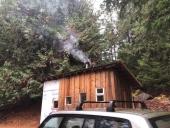
 1
1









 1
1




 I am going to open doors and windows and keep firing twice a day for a couple of days.
I am going to open doors and windows and keep firing twice a day for a couple of days.
 I just don't want to waste anybody's time, in case it is just my being picky.
I just don't want to waste anybody's time, in case it is just my being picky.




John Goodbody wrote:Last of the 3 was so pronounced that sent the house vibrating before I maneged to grab phone and make this clip.
regards, Peter





 1
1




For all your Montana Masonry Heater parts (also known as) Rocket Mass heater parts.
Visit me at
dragontechrmh.com Once you go brick you will never go back!







 Top bench is warm and bottom is getting there too. So if my last theory about cold mass is to be true, I should have nice draw in the morninig! Fingers crossed. Maybe I won't have to touch the bell (although I already removed stove gasket due to curiousity
Top bench is warm and bottom is getting there too. So if my last theory about cold mass is to be true, I should have nice draw in the morninig! Fingers crossed. Maybe I won't have to touch the bell (although I already removed stove gasket due to curiousity
 it was my hopelessness laughing
it was my hopelessness laughing 





 1
1













julian Gerona wrote:Hey John, how about testing for leaks. Say start a fire and then seal all inlets and outlets. Smoke will find its way to the leak. With regards to vibration I see it as air speed inside as vibrating back and port. Why not add a length on the stack say 1 meter. Hot air will always have the tendency to go up. When its hot enough in the barrel the flue gas will tend to rise countering the downward flow. Thus at some point it becomes a tug of war between flue gas trying to go up in the drum and flue gas trying to go up the stack.












 1
1





 I hope you know what I mean
I hope you know what I mean 
 I am not happy about the smell it gives off anyway. I thought it wouldn't because it is a stove paint at the end...
I am not happy about the smell it gives off anyway. I thought it wouldn't because it is a stove paint at the end...
 1
1








 I would very much love if some one could confirm or deny.
I would very much love if some one could confirm or deny.
 only showed us what to use to fix them to walls
only showed us what to use to fix them to walls 








 1
1




 nothing more and nothing less!
nothing more and nothing less!
 1
1




 However, both cleanouts in the other room leaked.
However, both cleanouts in the other room leaked.






 1
1






























Glenn Herbert wrote:The biggest issue I see with this concept is that it relies principally on heating air and moving that around, while the natural heating mode of the RMH barrel (and the rest of the mass) is radiation, which goes in all directions equally, not limited to horizontal, and heats all the walls, floor, ceiling, and people and objects in the room, without depending on making air hot. There is air heating as well from the typical RMH barrel, and a fan that moves air from the ceiling above the barrel down toward a cooler zone may be beneficial. It is important to take into account that moving air is an effective cooling mechanism, and moving air that is not sufficiently warm (above room temperature) will actually make people feel colder.



















|
A wop bop a lu bop a womp bam boom! Tiny ad:
Play Your Way to a Sustainable Lifestyle: Uncover Permaculture Principles with Each Card
https://gardener-gift.com/
|





